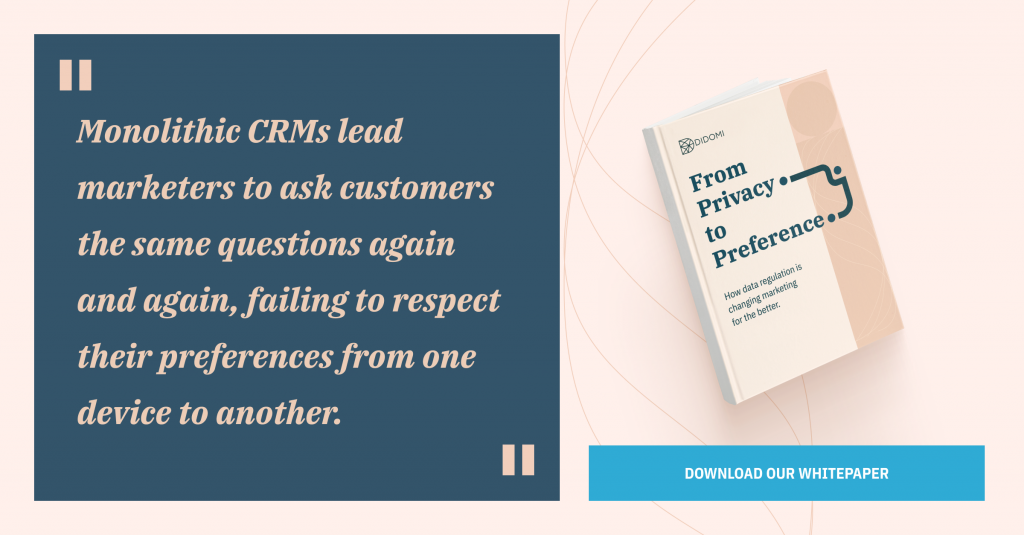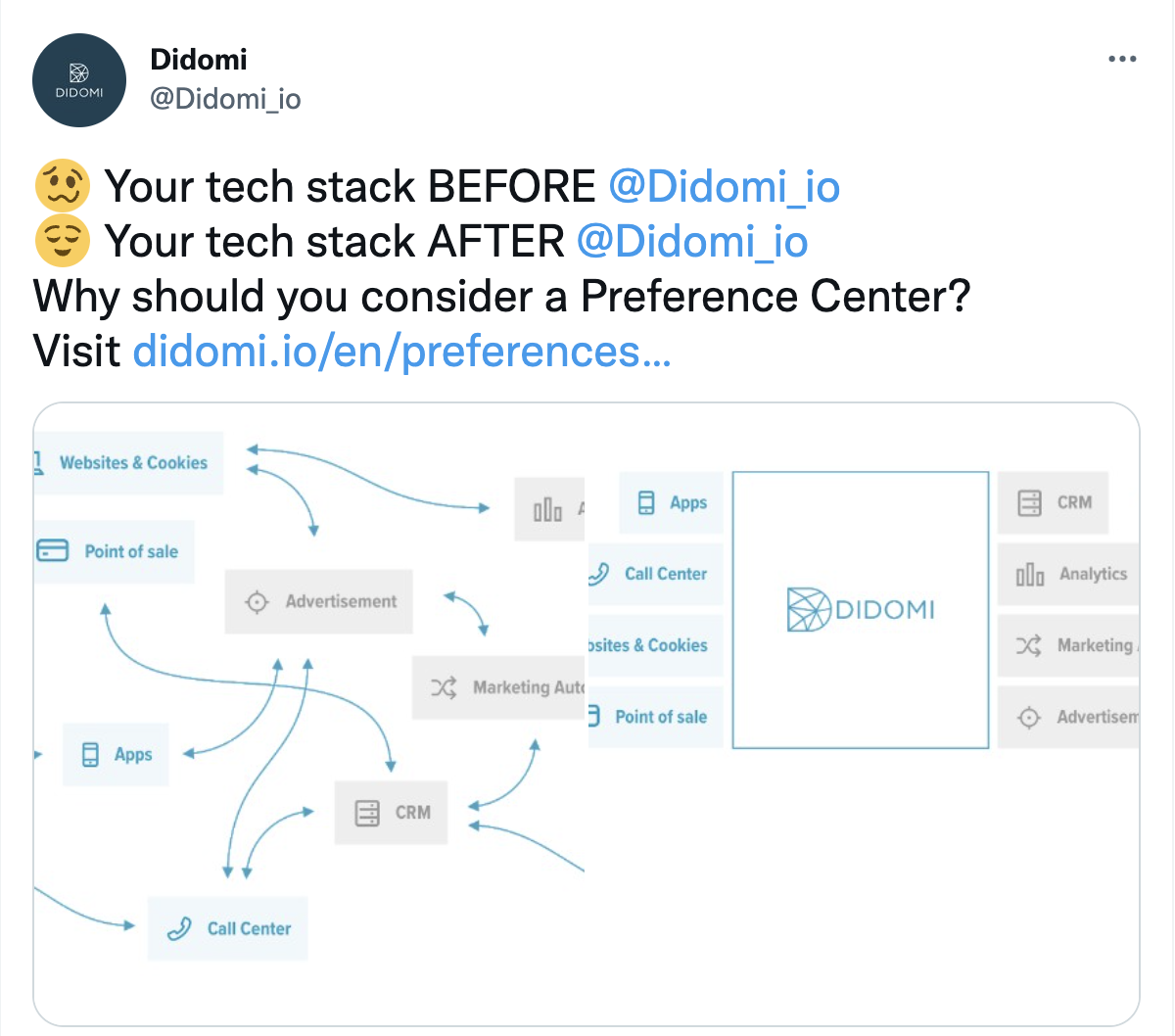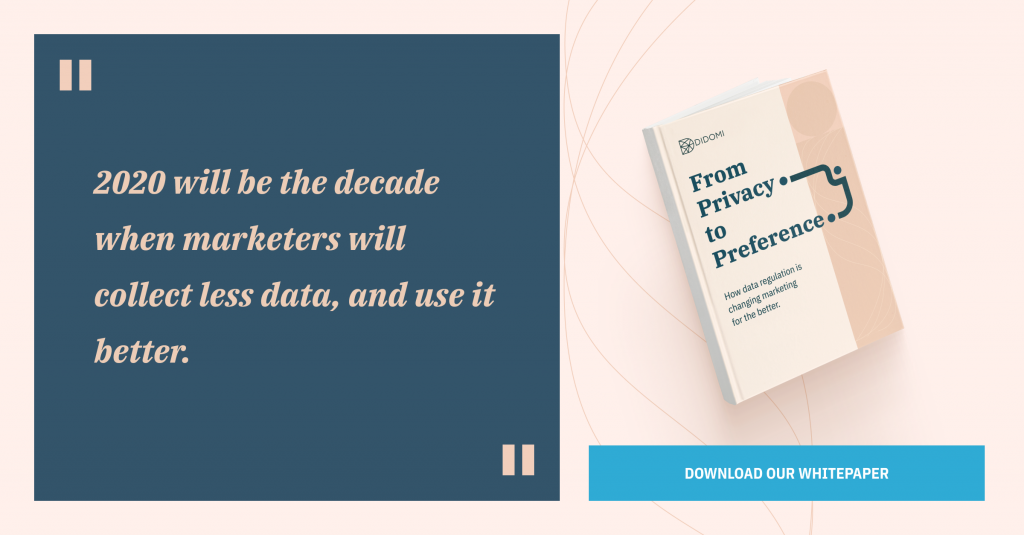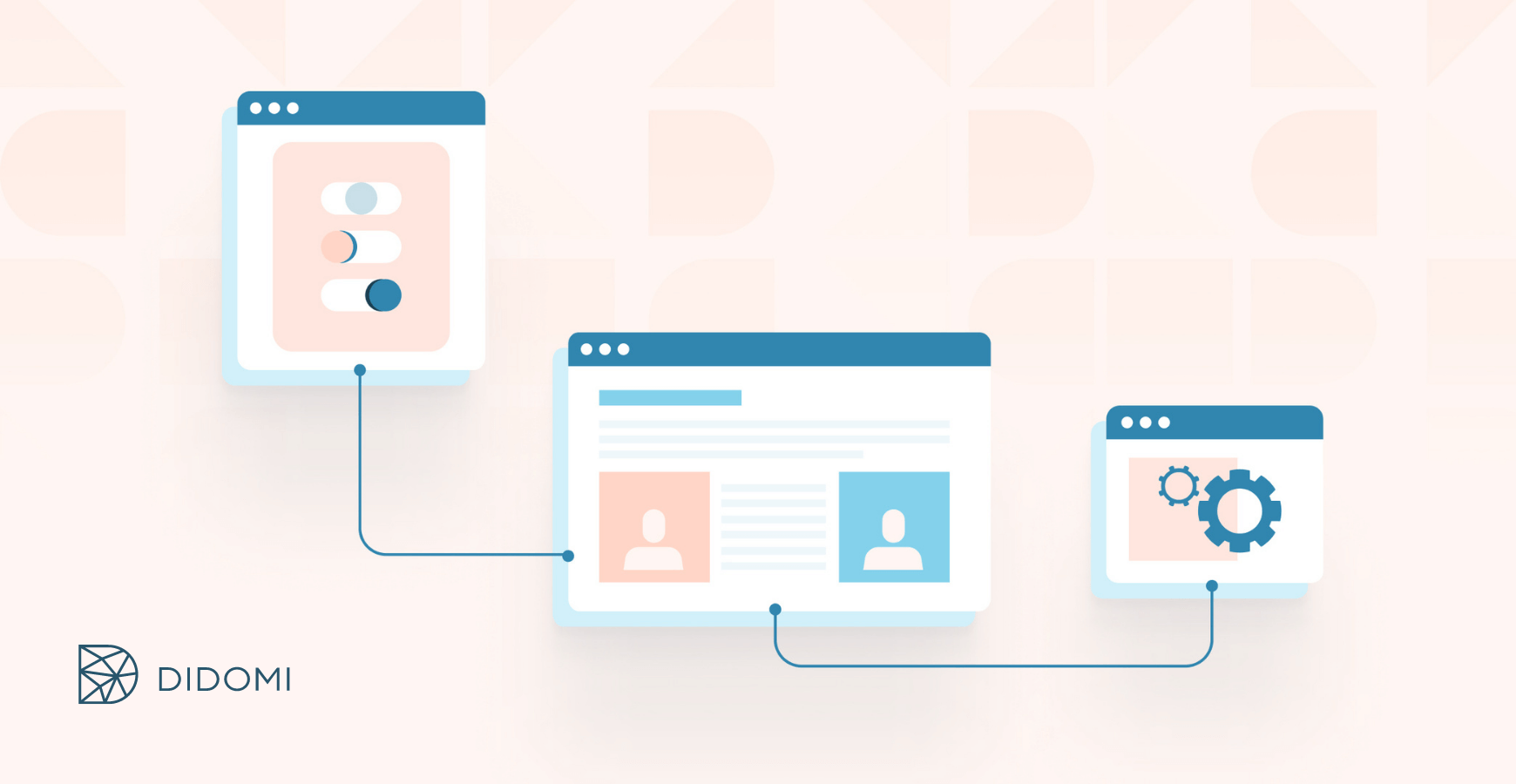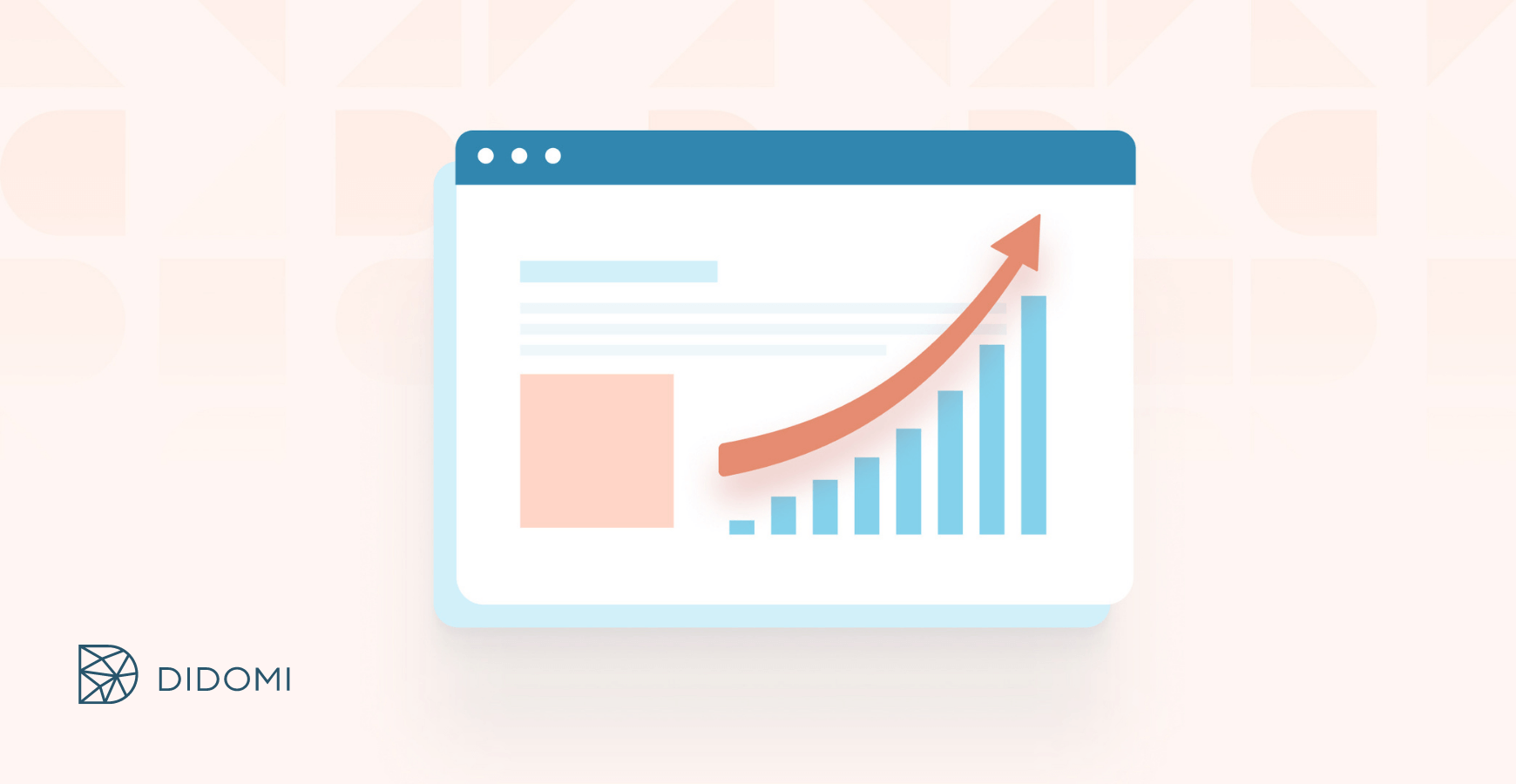Five years ago, most marketers still believed that understanding customer behavior was about collecting massive amounts of data about them. They quickly realized it was not. The key of marketing success has not changed: delivering the right information at the right time to the right person - only means vary over time.
Summary
-
Managing customer relationship with CRM software: a change in expectations
-
Preference Center helps you build a customer-centric approach
There is no one-size-fits-all answer to this challenge, but the better customer insights you have, the more likely you are to succeed. And today, insights rely on data. As of now, 91% of companies above 11 employees have invested in CRM software to collect data and follow their prospects along the funnel. With this increased visibility, they hope to be able to better understand customers expectations and get them moving across the traditional customer journeys: awareness, consideration, evaluation, purchase.
Yet, between 18 and 69% of CRM projects are considered a failure. Why is CRM software so unsatisfactory when it comes to current marketing expectations?
|
Pierre & Vacances Center Parcs Group streamlines customer opt-in across multiple countries and languages. They generate user trust and revenue by providing a better preference management experience. Want to find out how they did it?
|
Managing customer relationship with CRM software: a change in expectations
CRM software today faces two challenges: the increased complexity of customer experience, and a growing need for transparency and compliance regarding collection of personal data.
Creating a customer-centric experience
Today's customer experience has tremendously grown in complexity. Mobile, Web, brick-and-mortar experience, phygital... While CRM software is useful to store large amounts of customer data and to guide the customer through the buyer's journey, it lacks flexibility to adapt to these new trends. CRM software users only get to think in stages, email campaigns, opening rates and data collection. Interactions with customers are often reduced to e-mails and forms, lacking integration with the rest of the customer experience. Adding new types of interaction requires complex integration or juggling with tags, segments and internal notes.
Meanwhile, marketing expectations have changed, and marketers are shifting to a customer-centric approach. Customer-centricity implies rethinking the goals and processes of the company around the customers and their expectations, before thinking about the company expectations. In practice: instead of wondering how to get what they need from their customer (information, opening rates, webinar registrations...), companies must focus on the value they create for their customers, and adapt to the pace of their relationship with the brand.
In theory, CRM software would be the ideal candidate for this approach - in theory only. In practice, CRMs are monolithic and sequential. Customer journeys are not anymore. Customer journeys have grown increasingly complex, and no longer follow the canonical steps of the buyer journey. Touchpoints are everywhere - online, offline touchpoints, digital, physical, mobile - and higher customer expectations for a seamless experience have become the norm.
GDPR compliance in CRM software
Compliance with new data regulations has also added a layer of complexity. In order to ensure compliance with data protection regulations and ensure the validity of consent, the monolithic nature of CRMs incentivises marketing teams to ask for the same consents again and again, to fail to respect customer choices from one device to another, and to create discontinuity between the Web, mobile and offline experience. For customers, the result is an unpleasant feeling that the brand is trying to collect data against their will, and to take advantage of their inattention to collect more data than necessary.
CRMs have not been designed to take into account consent and privacy issues, and the best results marketing teams can expect is deciding which campaign should be sent or dismissed according to the consent that have been collected. And since most CRM softwares are all about emails and forms, marketers juggle with emails and forms to deal with those consent and privacy issues, even when irrelevant regarding customer experience.
Collecting data the right way
The marketing industry is massively adopting a customer-centric approach, and realising that leveraging their customer data matters more than massively collecting data they underuse. CRM softwares struggle to keep up with these expectations, as they are designed to fulfil the needs of companies, not the needs of customers.
Customer centricity is not about the amount of data collection
The use of CRM software skyrocketed as marketers collected more and more data, and CRM software is designed with data collection in mind. The more fields you get your customers to fill, the more complete your CRM looks. But getting a bigger amount of data does not help building a customer-centric approach; customer-centricity is about quality.
Quality of the customer experience, first. Here is a typical user experience on a website designed to capture data before giving access to an e-book about CRM software:

Painful experience.
The CRM Manager obviously wants to segment their audience according to the size of the company, but the prospect sees no added value in providing this information. The prospect has no idea if the content of the e-book is worth it, or if it fits their need as an SMB of a multinational company. They will likely enter wrong information, select first items in the lists to get access to the content faster.
Of course, it leads to a poor quality of data stored inside of the CRM. Polluting your CRM software with wrong information (a disposable email address, a false address or a randomly chosen position from a list) is a high risk when you ask for the same information for the tenth time during an interaction with the brand, or when you try to extort data from the customer without providing additional value in return. And poor data quality does not lead neither to revenue nor to a good customer relationship.
Replacing the CRM?
Should marketing teams replace their CRM with yet another miracle tool that would solve the problems of collection, quality and dispersion of customer journey? According to Gartner's study on CRMs, looking for the next miracle tool will only get you so far. Defining your strategy is the primary step, long before picking a tool.
Let's go back to basics. CRM software is not bad per se, but it should only serve its own purpose: providing an overview of leads to Marketing and Sales, centralizing correct and up-to-date information, and provide tools to analyze data and create metrics. Data collection is another challenge, with its own constraints. CRM is not, and cannot be, an all-purpose tool. As Gartner writes:
Only small and some midsize organizations are successful in meeting all their goals with a single CRM application.
Using CRM software tools like emails and forms as your primary tool for data collection is detrimental to the whole customer experience. The challenge of today is no longer the amount of data. Marketing teams are faced with more stringent regulations, more data-savvy customers, and a much more dispersed customer journey. And CRM is just not the right tool to tackle this new challenge.
Preference Center helps you build a customer-centric approach
So what does the ideal tool for data collection look like? For marketers, it's a mix of collecting relevant and qualitative data, integrating data collection in a top-notch user experience while complying with data protection regulation. Systems integration is also key: personal data collected should then be fed to other systems, including the CRM.
Want to find out how your business would benefit from a customer-centric bespoke Preference Center? Get in contact with us today!
Improving customer experience
Integrating a Preference Center in your marketing strategy will help most companies fulfil those needs, regardless of their size. A Preference Center is more than a dedicated web page where users can unsubscribe from a newsletter. It typically centralises all preference, consent and behaviour information linked to one customer in one place, where they can interact with the data, correct it and edit their preferences to reflect reality.
Customers don't need to fill those information: personal data is collected all along the customer journey. Instead of one big form with a high rate of abandonment, data collection is integrated in the global customer experience across all touchpoints, including mobile and offline touchpoints. Information about collection and consent is provided in context, with tremendous gains for transparency.
Integration with marketing tools
Preference Centers can be integrated with the CRM software in use, to make sure information is passed on correctly onto all systems. CRM fulfils its role of central point of personal data storage, but it does not constrain the user experience. No more headaches for marketers: the team has an overview of permissions, consents and preferences for every prospect in the database. This information is also made available to the customers, giving them control over what they want to share and under which conditions.
From the marketing point of view, it also ensures a better data quality: the customer can withdraw their consent if they deem it necessary, they can correct wrong or outdated information, and indicate the channels of communication they prefer. Marketing teams benefit from valuable and reliable information, since customers feel free to provide only the information they deem relevant. They can also expect better feedback on their campaigns, as customers have full control over the channels of communication they prefer.
Understanding and improving the conditions of data collection, facilitating the consent of the data subject and to correctly pass on the information within the different systems is just one more step towards a better knowledge of the customers, their preferences and the quality of their interaction with the brand.
GDPR compliance
Preference Centers help marketers make the best of personal data regulations, and specifically GDPR. They enable a respectful approach to data collection, bringing transparency and context to the experience.
Users are in full control of personal data they provided, and can easily exercise their rights:
- Right of access, and right to be informed, with an overview of all their personal data being processed and why,
- Right to rectification, with the ability to edit their personal data,
- Right to be forgotten, with the ability to delete their personal data,
- Right to examine and withdraw consent in the interface,
- Right to data portability directly from the interface.
The customer-centric approach is very close to the spirit of regulation: during their interactions with the brand, each customer builds a unique relationship, more or less committed, and at their own pace. The brand must respect this pace and adapt to the information that this individual is willing to provide, by not insisting on getting extra information, by understanding the channels through which the individual wishes to communicate with the brand, and by leaving them free to change their mind at each step, without having them communicate the same information over and over again.
Companies who develop a clever approach to data collection can even use consent as a metric. When a customer does not consent to collection or use of an information, they indicate that the value provided by the company in exchange for that information is not sufficient. This allows marketers to use consent rate as a valuable metric: measured correctly, it can help the marketing team assess the relevance of the user journey from the customer's point of view and work on continuously improving their relationship with the brand.
Marketing in 2010 was data-driven, and the amount of data collected was the main KPI.
Marketers in 2020 understand that mass collection is not always cost-effective, while focusing on the customer is beneficial to the brand.
2020 is likely to be the decade when marketers will focus on collecting less, but better.
Want to find out more? Download our whitepaper "From Privacy to Preference"
Want to ensure compliance and continue optimising monetisation?






